by Winding Pathways | Sep 30, 2021 | Garden/Yard, Nature, Pests
Poison ivy is a universally disliked and feared plant. It seems to grow everywhere. Encounter it and risk an itchy rash…..or worse. Some people are so sensitive to the oil on the leaf’s surface that they end up hospitalized.
Despite the discomfort it causes, poison ivy is an amazing native plant. It’s tough and thrives in any soil type, in drought or deluges. It loves living in the woods, at the edge of lawns and ballfields, and even in city vacant lots. It grows along ocean beaches and up mountains.
Scratching people may disagree, but there are two things to love about poison ivy. Both happen in the fall.

Keep your distance from this beguiling, colorful plant.
As days become cooler and daylight shortens poison ivy is one of the first plants to turn color. A month before sugar maples color up poison ivy leaves turn a glorious deep red. By late fall birds enjoy eating plentiful poison ivy berries. Apparently, they don’t get the itch and happily spread the common plant’s seeds when they poop them out.
There is one certain way to prevent a poison ivy itch. Enjoy it from a distance. Only contact with the plant’s oil can cause a rash. This can happen by touching the plant leaves or vines, patting an animal that has run through a poison ivy patch, accidentally touching clothes that have rubbed by poison ivy, or by breathing smoke with the oils in it when an area is being burned has poison ivy in it.
by Winding Pathways | Sep 9, 2021 | Garden/Yard, Nature, Pests, Trees/Shrubs
We’ve got a peach problem.
Iowa’s frigid winters don’t favor peach trees, but we’ve got a tough one in the front yard that’s withstood temps down to 30 below zero. Each May it graces our yard with pink blossoms that transform into smallish, tasty peaches that ripen around Labor Day.
We love peaches. So do deer. That means that every fall we play a waiting game with them.
Peaches look ripe a few weeks before they truly soften and ripen. When they’re hard as stones they don’t taste good. We know it. So do the deer. This starts the tricky part.
When will they be ready to pick? If we don’t harvest them at just the right time the deer will do it for us. They’ll devour every single one the night before we intend to pick. This year we ran a wide circle of wire mesh around our tree, but we know hungry deer will figure out how to foil it.
-
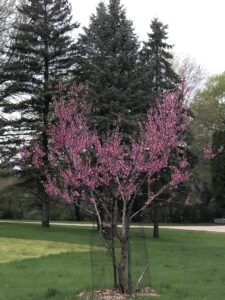
-
Each spring the fragrant pink blossoms grace our yard.
-
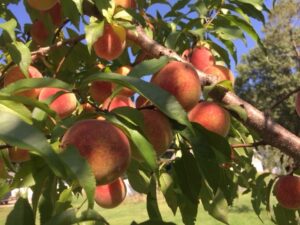
-
Deer sense when peaches are ready to eat.
As we write this on September 2nd our peaches are still hard. The deer are watching and waiting. We know because we found fresh scat just outside the wire fencing last night. We’ll let our readers know who gets the harvest.
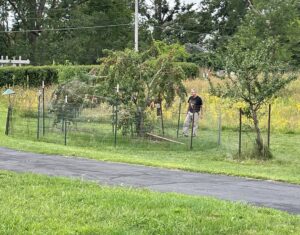
Adding extra fencing and stakes may keep the deer back.
by Winding Pathways | Jun 17, 2021 | (Sub)Urban Homesteading, Pests
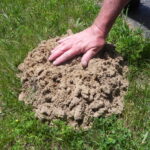
Moles sometimes push up excess dirt.
It’s that season again. Recently we spotted a symmetric dirt cone poking up in our lawn. Fortunately, it wasn’t an early-stage volcano about to erupt. Rather, a mole pushed dirt out of the way so it could continue tunneling.
People hate moles for forming similar dirt piles and their humped tunnels that lawnmower blades sometimes catch. Here’s some basic mole information to help change perspective from a “problem” to a resource and “radical welcoming”.
A Mole Primer
Moles are small mammals of several species that live across North America, Asia, and Europe. They make their living tunneling through the earth to find earthworms and other invertebrates to eat. Contrary to popular belief moles don’t eat plants or roots. They make two types of tunnels. One is fairly deep and is a mole’s highway. It’s for transportation. The other is the familiar humped tunnel moles create to find food that usually is just below the soil surface. Every once in a while, a tunneling mole needs to get rid of some dirt, so they push it to the surface, creating a molehill.
Mole or Gopher?
People confuse moles with gophers. Both are small tunneling animals, but they are very different in these ways:
- Moles eat invertebrates, not plants. Gophers eat plants and roots.
- Moles are most common in moist shady soil and suburban yards. Gophers are more common in open sunny areas, like pastures, and rarely enter suburbia.
- Moles create symmetric hills of dirt. Gophers make elliptical-shaped mounds.
- Mole populations are usually small, while there may be many gophers living in an area.
By softening and aerating the soil both types of animals promote long-term soil health. Often an area bordering a mole tunnel will have the greenest grass in the lawn, for example.
Killing Moles
Mole dislike is so intense that many people work hard to kill any that dare tunnel in their yard. Here are two common mole weapons and why we don’t use them:
- Plunge-type traps impale a hapless mole. We worry that a neighborhood child or someone’s pet could be speared by one of these traps, which also are cruel.
- Poison peanuts are sold in garden stores. The package may say the peanuts will kill moles……and they will if you can get a mole to eat one, but remember that moles eat worms and insects, not peanuts or plants. A peanut is a plant. So people who buy poisoned peanuts are wasting their money and poisoning critters that may eat the poisoned peanut. Like a favorite, curious dog.
What We Do with Moles at Winding Pathways
We view our moles as another interesting and beneficial animal that shares our yard. Yup, mole tunnels kill a strip of grass in the short term, but in the long term, mole activity improves the soil. Worms and most other invertebrates contribute to soil health, so we know if we have moles, we have a healthy lawn.
What to Do About Moles
There are two ways to deal with moles. First, a homeowner can set traps and poison and attempt to kill beneficial animals. Second, forget trying to “get rid” of moles. Instead, just tamp down their tunnels before mowing, and don’t worry about them.
We follow the second.
by Winding Pathways | Mar 11, 2021 | (Sub)Urban Homesteading, Birds, Pests
Millions of people love their cats. Some 36% of households keep an average of two cats. They are the second most popular companion animal in the United States, lagging only behind dogs.
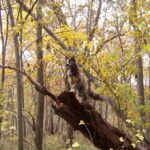
Cats decimate bird populations.
Some cats cause problems, especially when owners allow them to free-range the neighborhood. According to the American Bird Conservancy, they kill 2.4 billion birds a year and may be a significant cause of the decline of many species.
Catios to the rescue!
A growing number of cat lovers, many who also enjoy bird watching, recognize the problem and are increasingly adding a catio to their home. Wonder what it is???? It’s simply an enclosure that allows the family cats to enjoy fresh air, sunshine, and a bit of adventure without allowing them complete access to the neighborhood.
Many catios are enclosed patios, which spawned the name, that let cats play outdoors while their owners enjoy lounging or socializing nearby. They are relaxing places for both species. Other catios are small and positioned outside windows. Catios can be either purchased or homemade and often an existing patio can be modified into one.
Safety First!
Although cats love roaming the neighborhood, it is not a safe place. They pick up ticks and transfer them to humans, suffer accidents, are killed by cars as they cross streets, and are taken by predators.
A catio is a good solution to several problems. It allows cats to enjoy the outdoors safe from cars and predators in a place where they can’t kill birds. And, the owners always know where their cat is.
Harmony
An array of catio photos is visible on Catio Spaces. Many other websites feature them. Catios are a great way for cat lovers to show care of wildlife species, keep their cats safe, and live in peace with human neighbors who are frustrated when they spot a feline stalking birds under their feeder.
by Winding Pathways | Dec 3, 2020 | (Sub)Urban Homesteading, Garden/Yard, Mammals, Nature, Pests
What a year this has been! Coronavirus altered the lives of nearly everyone. Many of us now work from home and spend the day staring at a computer screen and attending zoom meetings.
A delight of working from home is entertainment right outside the window. Sometimes we take our eyes off the screen, glance outside, and grin as we watch chipmunk antics.
No Need To Feed
We don’t really feed our chipmunks. They’re opportunists. When chickadees, nuthatches and other birds drop seeds from hanging feeders the chippies are right there filling their cheeks with sunflower seeds and dashing off to store them in their underground burrows.
Manly people detest these small, beautiful mammals and cite the damage they do to retaining walls and lawns. Our retaining wall is crafted of huge glacial boulders. Its many nooks and crannies are perfect for chipmunks but are so sturdy chipmunks can’t damage it. They give us cheer in a perplexing year.
Many species of chipmunks live in the United States but the one most common in suburban areas between the Atlantic and the Great Plains is the Eastern Chipmunk. Almost everyone can identify this animal that only tips the scale at two to three ounces. Counting its tail, a big one might stretch a foot long.
Where Do Chipmunks Live?
Chipmunks love what biologists call “structure”. A pile of firewood or old lumber, a brush pile, a rarely used shed, or a retention wall is structure that makes a dandy home for chipmunks. They typically create an extensive subterranean home under structures that is an extensive tunnel system with several entrances to the surface.
What’s In a Name?
Chipmunks were named by the Ojibwe Tribe with the words that mean, “one who descends trees headfirst.” Climb they can! Chipmunks scamper up and down trees and bushes and easily reach our bird feeding platform. They prefer sunflower seeds and stuff their cheek pouches until they seem ready to burst. Then they scoot off to store seeds down in their tunnels. We wonder how big that pile of seeds might be! Chippies also eat wild seeds, acorns, and even an occasional insect.
During the coldest weather chippies stay underground and sleep in a kind of torpor. They don’t hibernate and probably enjoy snacking on the sunflower seeds they cashed months before. Last winter one tunneled under the snow and emerged under our bird feeder for fresh seeds.
Overall Delight
We love watching our chipmunks chase one another up, down and around the feeder and retaining wall. Suburban chipmunks are fortunate. Snakes and raptors love snacking on them but people keep long, skinny reptiles out of yards and not many hawks venture near homes. Since chipmunks are day shift animals our barred owls don’t get a crack at them because they work the night shift.
So, in exchange for a safe place to eat, a scoop of seeds daily, and a cozy retaining wall to burrow in, our chipmunks give us a humorous and interesting break from working at home chores. CBS recently aired a short on a food editor who, during Coronavirus time has catered to a chipmunk outside her home. Sweet and tender show!
-
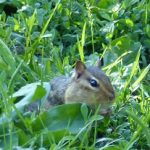
-
Foraging for seeds.
-
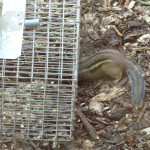
-
Having excavated, the chipmunk now enters the tunnel to get the corn.
-
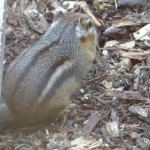
-
The chipmunk figured how to tunnel under the live trap, gather up the corn and emerged with pouches full.
-
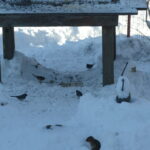
-
Chipmunks forage under the bird feeding platform.
by Winding Pathways | Oct 22, 2020 | (Sub)Urban Homesteading, Mammals, Pests
Early one September morning a disturbing sight greeted us. The metal post holding a suet feeder high off the ground was bent. The feeder was gone. After a search we finally found it where our nocturnal thieves had abandoned it after devouring the suet.
Many people are frustrated when daytime squirrels gobble up feeder seed, but other mammals visit feeders unseen after sunset. Not all are as rough on feeders as raccoons and all night visitors are interesting but they can also be frustrating.
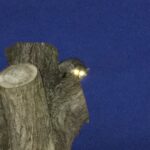
Raccoons are strong and hungry.
Up in the wee hours sleepless or just to get a snack? Shine a flashlight beam on the feeder. You may spot raccoons, deer, flying squirrels, or even a bear! They all like birdseed and some relish suet.
Raccoons live nearly everywhere, even in big cities. Our son once sent a picture he took of one raiding a dumpster in New York City. Occasionally they are out on cloudy days but mostly they are nocturnal.
Raccoons are common, numerous, powerful, and gregarious. Sometimes a whole family visits a feeder after dark. Excellent climbers, if they can’t shinny up a slippery metal pole to reach seed, they might just bend it over as they did at Winding Pathways. They love suet but also eat corn, sunflower seeds, and many other foods people put out for birds.
One of the most endearing animals to visit feeders are flying squirrels. There are two species but both are nocturnal and are almost never seen during daylight. Flying squirrels often live in big dead hollow trees and are more common than most people realize.
Flying squirrels are misnamed mammals. They can’t fly. They should be called gliding squirrels, for they spread loose skin on their sides and glide from the top of a tree to the ground – or bird feeder. These mammals weigh only about two ounces, about half that of an Eastern chipmunk. In comparison, a mature gray squirrel is ten times heavier at about 20 ounces.
Flying squirrels are shy and beautiful. Seeing one is a thrill.
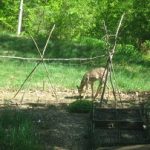
Deer In Garden Photo by S. Fehsinger
Like raccoons and flying squirrels, deer love birdseed. Sometimes they visit during the day but we see them more often after dark. If a feeder is well seed stocked in the evening but is empty come morning deer are likely culprits. Look for their tracks and droppings to confirm the visit.
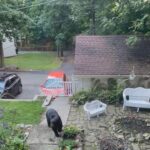
Bears make themselves at home anywhere.
Bears
Gads. Bears at the feeder! Could be. We don’t live in bear country but they are common over much of the United States. Mostly nocturnal, they love birdseed and suet. A 300-pound bear can rip down the most armored feeder and they’re skilled trash can scroungers as well.
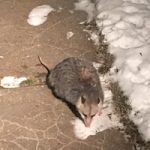
A ‘possum snuffling for food. Photo J. Jones
Skunks, Possums, and Rats
Skunks, opossums, and Norway Rats all love birdseed. Like flying squirrels and raccoons, they are nocturnal. Skunks and possums are native animals that can be comical, but no one wants rats around. They are dangerous pests capable of spreading disease and gnawing on houses.
REDUCING NOCTURNAL FEEDER VISITORS
There’s an effective way to discourage nocturnal feeding wildlife. It’s a two-step process:
- Only put out the amount of seed birds are likely to eat in a day. Empty feeders may attract nocturnal animals but pickings are slim and discouraging.
- Better yet bring all feeders inside by sunset. Store them overnight in a metal trash can with a tight-fitting lid to keep mice from being tempted to raid it even if it’s indoors.
Feeding birds is entertaining and educational. We love having colorful activity just outside our window. We’re not thrilled when raccoons tear up the feeders, so when midnight raiders help themselves, we bring feeders in each evening.














